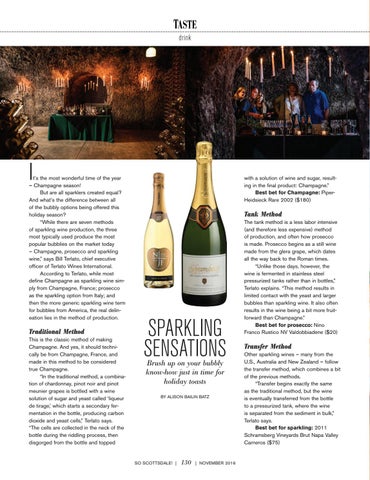drink
I
t’s the most wonderful time of the year – Champagne season! But are all sparklers created equal? And what’s the difference between all of the bubbly options being offered this holiday season? “While there are seven methods of sparkling wine production, the three most typically used produce the most popular bubblies on the market today – Champagne, prosecco and sparkling wine,” says Bill Terlato, chief executive officer of Terlato Wines International. According to Terlato, while most define Champagne as sparkling wine simply from Champagne, France; prosecco as the sparkling option from Italy; and then the more generic sparkling wine term for bubbles from America, the real delineation lies in the method of production.
Traditional Method This is the classic method of making Champagne. And yes, it should technically be from Champagne, France, and made in this method to be considered true Champagne. “In the traditional method, a combination of chardonnay, pinot noir and pinot meunier grapes is bottled with a wine solution of sugar and yeast called ‘liqueur de tirage,’ which starts a secondary fermentation in the bottle, producing carbon dioxide and yeast cells,” Terlato says. “The cells are collected in the neck of the bottle during the riddling process, then disgorged from the bottle and topped
with a solution of wine and sugar, resulting in the final product: Champagne.” Best bet for Champagne: PiperHeidsieck Rare 2002 ($180)
Tank Method
SPARKLING SENSATIONS Brush up on your bubbly know-how just in time for holiday toasts BY ALISON BAILIN BATZ
SO SCOTTSDALE! |
SS_130_131Taste_Nov16.indd 130
130
The tank method is a less labor intensive (and therefore less expensive) method of production, and often how prosecco is made. Prosecco begins as a still wine made from the glera grape, which dates all the way back to the Roman times. “Unlike those days, however, the wine is fermented in stainless steel pressurized tanks rather than in bottles,” Terlato explains. “This method results in limited contact with the yeast and larger bubbles than sparkling wine. It also often results in the wine being a bit more fruitforward than Champagne.” Best bet for prosecco: Nino Franco Rustico NV Valdobbiadene ($20)
Transfer Method Other sparkling wines – many from the U.S., Australia and New Zealand – follow the transfer method, which combines a bit of the previous methods. “Transfer begins exactly the same as the traditional method, but the wine is eventually transferred from the bottle to a pressurized tank, where the wine is separated from the sediment in bulk,” Terlato says. Best bet for sparkling: 2011 Schramsberg Vineyards Brut Napa Valley Carneros ($75)
| NOVEMBER 2016
10/21/16 12:39 PM
